Table of Contents
People remember their managers for their attitude and management styles. What aids the memory is how they succeeded or missed to achieve goals and impress stakeholders while operating under different, often competing interests.
Some managers are coaches, some are democratic, some are dictatorial , and yet a few are consensus builders. Each effective management style comes with positives and negatives, many managers use a mix of all to move ahead. Ultimately, the managers with the most successful teams are the ones who help each member of the team to grow.
For example, whether you’re already the head or manager of a team, or you’re leading a project for the first time, you still can choose your style. How it will impact the individuals you’re in charge of, and the goals you have to achieve.
Remember effective management demands balance in the work environment employees irrespective of their background feel empowered. They feel confident about their potential and achieve their best. You can be strict or gentle, your team may feel good and happy in a medium where inclusivity is desired. Your success would eventually lie in how you played on every individual’s skills, abilities and worked together within the group.

Role of managers
Let us understand why organisations need Managers? And what makes a manager?
The three basic traits of any organisation are
- a purpose,
- Made from individuals,
- And a conscientious structure.
A substantial number of today’s age organization are more open, adaptable, and receptive to changes.
Therefore managers are critical to the firms, companies or organization for the following three reasons.
- Organizations need managerial aptitude and abilities to navigate through the unclear, complex, and disordered state of affairs
- Second, managers are basic for task setting and achieving the targets
- Lastly, managers influence employees productivity and loyalty
Enroll in our PMP Certification today and develop a strong foundation in the principles of project management.
The Importance of Effective management
I understand being designer or engineer or finance officer or anyone not related to the field of management, it is difficult for you to visualize management helping you in your mission and you question why management is important? Well to answer that
Effective management is basic to forecast, plan, execute, coordination and control over operations. It unites the group, channelizes their performance and directs them towards the organization’s goal and objectives.
Effective management benefits the firms in many ways like
- achieving the organization goals through coordination in production and directing everyone’s focus on completing the desired goals and targets.
- Again optimal utilization of the resources both human resources and products,
- getting the best out of people and reducing waste.
- cost control and its reduction with the help of proper planning to economize inputs and optimize the outputs.
Effective management is an answer to all difficulties. And it maximizes the benefit which is supportive to business and society at a minimal cost through generating employment that creates income.
The 7 Effective Management Styles
Management is the technique of working with and via others to successfully achieve the organizational goals. Making efficient use of the available resources. If we could summarize all the works, we will end up with seven styles used mostly all over the world.
First comes the ‘’Visionary or imaginative style’’ this style is most proper when an organization needs another heading.
Second, comes the ‘’Coaching style’’ it centers on creating people, helping them improve their performance and aligning their goals with organizational goals.
The third style is known as an ‘’Affiliative style’’ which underlines the significance of collaboration and makes group harmony by strengthening peoples communication.
Yet another approach is a ‘’Democratic style’’ where manager solves issues or makes changes by asking for feedback, recommendations, and ideas of the teammates.
In ‘’Pacesetting style’’ the manager formulates high standards for performance. And it has shrouded advantage: quick acquiring of the outcomes within the short period,
‘’ Autocratic style’’ this is the style where the manager alone defines the task. Discipline or fear influences the performance of an employee and non-compliance awaits results not desired
Lastly, you have the ‘’Laissez-faire style’’ that allows what autocratic style prohibits. In this, the workers are allowed to participate in decision making, with management guiding them whenever required.

Visionary management Style
Managers who practice the visionary management style shoulder the responsibility of moving the company into a larger arena. They promote cohesion and resolve to shine through times of uncertainty.
Visionary managers are expected to motivate the company to stay the course and excitement about its mission and vision continues. Visionary leaders are moved and energized by what a company can become. They do not cow down with technical details. Primarily, they are big picture people determined enough to take the company into a new era of innovation and development.
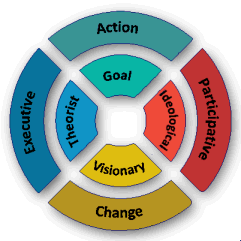
Lets us now examine the traits that make a leader or a manager a Visionary
Favorable Toward Innovation :
Visionary leaders are focused on relinquishing the past change the status quo and prepare the company for in new projects, acquisitions, or initiatives.
Resilience :
Visionary managers and leaders rise above old ideas, company politics, and external pressures. And they do it by their sheer tenacity and determination not only this they guide the company through uncertain times
Strategic Thinker:
Good visionary leaders plan for and think strategically for what they want the organization to look like
Intelligent Risk Takers:
Visionaries are at ease with the uncertainty. And they take as many measures possible to ensure the plan laid by them is successful.
Skilled Communicators:
Visionary leaders can cause others to see where they are going and agree to the move toward the new vision.
Expert Organizers:
Visionary leaders emphasize creating the team around them. They will be intrinsic to the process of putting departments, functions, and operations together for achieving the new vision.
Intensely Focused and Enthusiastic:
Visionary leaders exercise and exhibit self-control and self-discipline to bring position change and influence their subordinates.
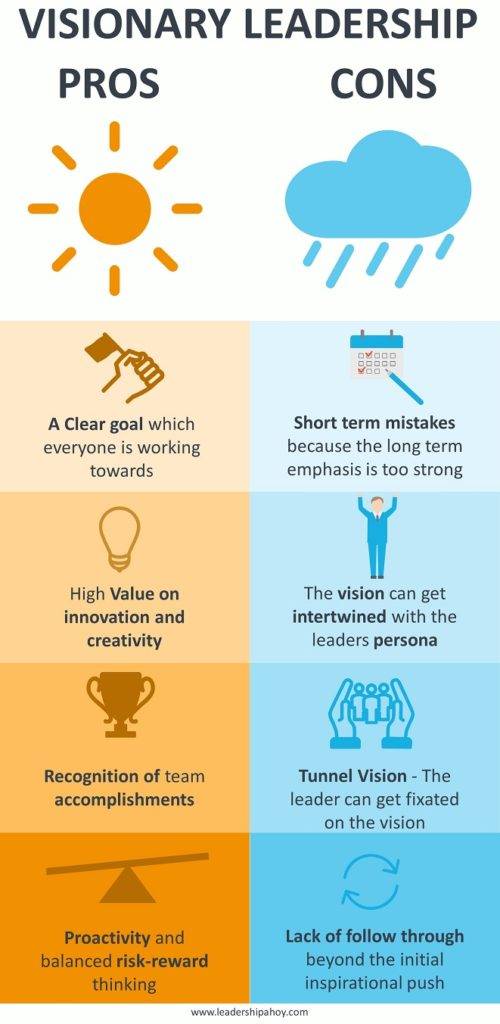
Weaknesses of Visionary Leaders
A One-Track Mind :
Visionary leaders could be too consumed by the vision that they may not put attention to necessary details.
Focusing on the Now :
They focus too much on the future and accomplishing a future goal as a result they may overlook the situations requiring their immediate attention
Carrying on in Their Absence :
If a leader or manager alone personifies the driving force for a vision, as a result, the idea has a chance of disappearing with them.
Other Ideas May Take a Back Seat:
If a visionary leader is engulfed by a vision completely, they risk missing out on future ideas benefitting the company.
And so we see Visionary leadership has several strengths and also several weaknesses just like the other management styles. If a leader or a manager has to inspire a substantial change in the vision. The Visionary style becomes an effective management style to adopt. The objective is to motivate team members to effect change and make the organization’s overarching goal a reality
Democratic Management Style
If an organization redistributes authority and power between managers and employees to encourage employee involvement in the decision-making process, it is said to be practising Democratic style of Management
Principles used to practise the democratic management style are deliberation, inclusiveness, equal participation and self-determination.
The three features given below are the main characteristics of democratic leadership style
Responsibility Delegation
A democratic leader will have responsibility delegated among the team members to facilitate the contribution of members in the decisions making process.
Empowerment of Group Members
Leaders entrust their team members with the requisite authority. As a result, the members feel duly equipped to complete their tasks.
Aiding the Process of Group Decision Making
The important role played by a democratic leader is to ensure that democratic deliberation takes place during the group decision making process.
Alike every other style of leadership, there are advantages and disadvantages of democratic leadership too.
Some of the benefits and drawbacks are outlined below:
Advantages of Democratic Leadership
The approach of democratic leadership plays a significant role in restoring job satisfaction, sense of autonomy, control and participation is encouraged within the democratic leadership style. Below are some specific advantages of democratic leadership:
Solution for Complex Problems
Democratic leaders are adept in solving complex issues. The democratic leader often thinks innovatively and inspires others to do the same. They make complex and strategic problem resolution speedy enough.
Good Business Fit
Democratic leaders ensure that team members engage well. work well with other individuals. And they are best equipped to function in large corporate environments in which co-operation and communication is the crux.
Democratic Leaders built Strong Team
Team members under democratic leadership stand in support and strength for each other. The leader gets the opinion of everyone factored in as a result honesty thrives, and collective working is at its optimum
Foster Creative Environments
Democratic leaders effectively build creative environments as they uphold the input and innovation of team members. democratic leadership support and nurture creativity and innovation.
Shortcomings of Democratic Leadership
Can Appear Uncertain
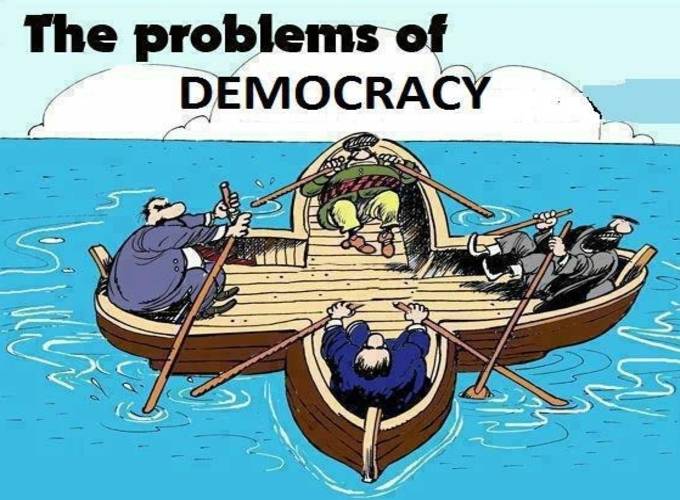
Democratic leadership are perceived as indecisive at times. For example in case of a crisis, leaders must be very directive but democratic leaders fail in an authoritarian role.
Time Consuming
The consultation process could result in delays. Consulting several individuals and collecting a variety of opinions consumes a lot of productive time. And many Democratic leaders find it difficult to compromise without affecting the essence.
Become Apologetic
Where there are a variety of solutions available, and the only one can be implemented for the success of the project. The democratic leaders will have a field day in apologizing and smoothing things over with individuals whose ideas were rejected.
Majority of corporate cultures practise the democratic management style. Democratic leaders deliver Good results. The same is reflected in employee satisfaction level exhibited in such an environment. Nevertheless, the democratic leadership approach will not always be an effective management style to adapt to. A democratic leader will have to learn to turn into an authoritarian and come to a decision in certain situations.
Affiliative Management Style
The key characteristics of Affiliate Management style are
- They have strong communication skills
- Their primary play is a positive feedback for creating success.
- These managers are confident and make everyone realise that a setback is something everyone encounters.
- They maintain a positive attitude, and love their creativity,
- Committed to producing consistent results
The above points spell out the key advantages and shortcomings of the affiliative leadership style of management.
Advantages of Affiliative Leadership

1. Establishing the Feedback system
Affiliative leaders are always willing to provide positive feedback to their direct reports. These leaders are quick to recognise and reward someone has chosen to go above and beyond the call of duty.
2. Quick Conflict resolution.
Affiliative leaders hate conflict. They proactively read the relationships between their direct reports. They actively without losing a moment facilitate the healing relationships process
3. Employee being comes first.
Affiliative leaders work hard towards making the work to be a positive experience for their employees. They focus on creating harmony within the workplace resulting in higher levels of productivity
4. Reduces stress level.
People who work for an affiliative leader feel valued for what they contribute. That makes them feel happier, and it reduces stress naturally.
5. Help people recover from difficult incidents.
Having an affiliative leader at the helm, everyone finds it easier to recover from a bad incident which occurred because there is such a positive presence encouraging them each day.
Disadvantages of Affiliative Leadership
1. Avoids conflict.
These leaders avoid dealing with conflict. A supervisor practising this leadership style may be lightning-fast on repairing the relationships between team members if a conflict occurs.
2. Reduced team productivity levels.
Personal integrity and self-discipline of each team member is the core factor to maximize productivity levels in the Affiliative style of Management. Productivity levels plummet if these leaders overlook an underperformer which can have a domino effect.
3. Struggles with complex problems solving
An affiliative leader offers positive feedback only to their direct reports. When they are working with them they remove the negative or constructive feedback from consideration

4. Complacency Build up.
Complacency often sets in people reporting to leaders practising the affiliative style of management. Over a period of time, even skilled workers become redundant because they made no efforts to keep up with modern practices and techniques.
5. Reduced focus on the Vision
Moreover, if leaders focus too much on the direct reports and their welfare more than their responsibilities to the company. Then it becomes easier to lose sight of the overall mission.
Affiliate style of management creates positive environment leading to increase in productivity and employee satisfaction. People do improve and correct themselves in such an environment. However affiliative leadership due to its characteristics leads to complacency, lower productivity, and resistance to change over time.
Coaching Style of Management
Coaching leadership style inculcates the habit of trying something on their own in the employees. The leaders here do not directly explain how to do something, or delegating work to their direct reports
Advantages of Coaching Leadership
1. Builds a positive workplace environment.
Leaders who utilize the coaching management style create a stable, positive workplace environment. That is because the objective of this leadership style is to help others to improve their performance and in turn achieve your goals too
2. Employees are clear about expectations from them.
Coaching leaders are transparent with their team. They share the expectations openly and clearly to ensure that everyone is clear about the job roles.
3. New skills coaching to the the Individual Worker
Personal mentorship is very high in this style of management. The mentoring processes focus on potential building and improving skill competence levels at all level.
4. Reduced attrition rate.
One of the biggest issues facing organizations today is the employee attrition. It is only after much time is lost and efforts are made that a company is able to replace the soft skill that it loses in case of an attrition
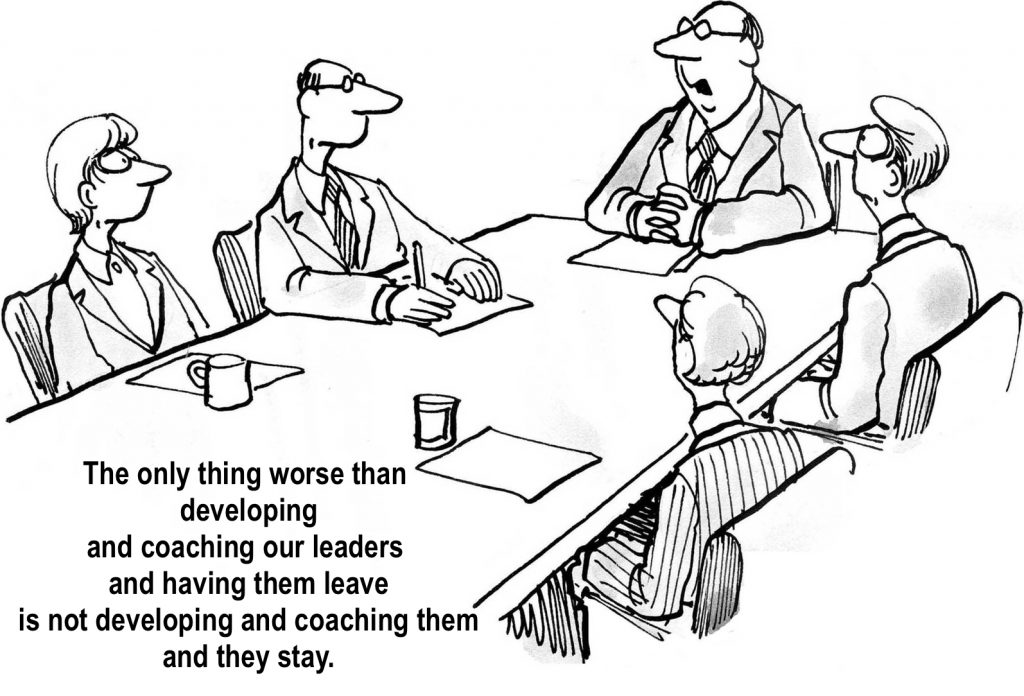
Coaching reduces attrition
Disadvantages of Coaching Leadership
1. Coaching leadership style is a slow burn process.
Modern workplaces do not consider coaching management style as a very effective management style. Leaders aren’t using this option for one basic reason: they don’t feel like they have the time to stop and help others with their responsibilities.
2. Coaching leaders must be skillful leaders.
The skills of the leader involved decide the effectiveness of a mentoring or coaching relationship
3. Mentoring does not always serve the purpose.
When a coaching leader is forced to work harder than the person being mentored to create results, then a situation is created that will lead to frustration and disappointment.
4. Specific coaches for each situation.
Great coaches don’t always turn into great leaders for a specific organization. The organisation needs to find the right person with the proper skillset

The authoritarian leadership style is one where a single individual controls the decision-making process and no input is taken from group members. Autocratic leaders typically make decisions based on their ideas and judgments and seldom invite advice from direct reports. Autocratic leadership means complete, authoritarian control over a group.
Some of the notable traits of autocratic leadership include:
- Permits minuscule or no input from the team
- Requires leaders to own decision-making process
- Wants managers with the authority to dictate work methods and processes
- Dissatisfied team member
- Promotes highly structured and very rigid environments
- Rules out creativity and out-of-the-box thinking
Benefits
The autocratic style appears to be a negative one. Overuse or wrong group or situation application tends to bring down the effectiveness of Autocratic leadership style. But autocratic leadership has its advantages as well.
Provides Direction
Autocratic leadership works well in small groups where leadership is missing. In such instances, a credible leader with autocratic style can lead the group, trust tasks to different members, and communicate solid deadlines for projects to be completed.
Relieves Pressure
In immense pressure situations, the autocratic style of management works pretty well. This allows members of the group to focus on performing specific tasks without worrying about making complex decisions
Offers Structure
Autocratic leaders tend to do well when they build up a clear work structure. With each person having a task assigned, a deadline, and rules to follow, the project is finished in time
Downsides
While autocratic leadership may be an effective management style in some situations. However, this leadership style can be problematic in certain cases. Team members consider the autocratic leadership style using managers to be controlling, bossy, and dictatorial.
Ignores Group Input
Autocratic leaders not acknowledging knowledge and expertise that group members might bring to the situation is a very big grey area. Ignoring other team members in such situations hurts the overall success of the group.
Derails Employee Morale
If people feel wanted and their contributions are considered as valuable for the future of the group. They deliver and perform better. Since autocratic leaders do not allow input from the group, and hence the followers’ morale nosedives
Autocratic leadership too suffers from potential pitfalls. Autocratic leadership is often most effective only when it is used in specific situations. Juxtaposing this style with other management styles like democratic or transformational styles can result in better group performance.
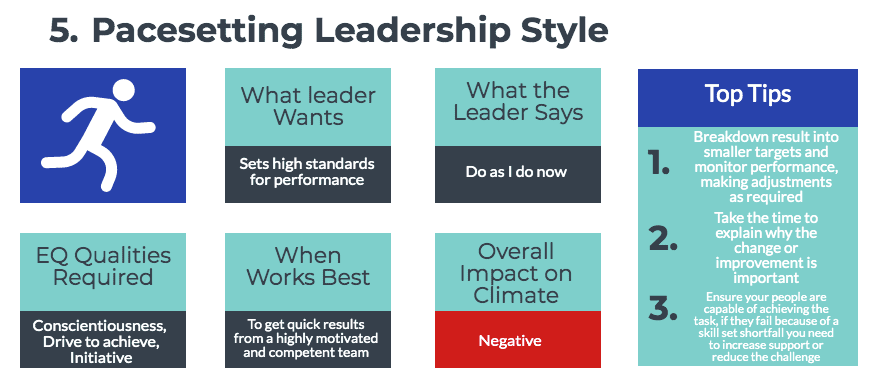
Pacesetting Style Of Management
The pacesetting manager is one who wants to exemplify himself by creating excellence. He works like a pro.
The pacesetters believe: “Do As I Do, Now!”
They lead by example and never ask their team members to perform a task unless and until they have done the same.
- Pacesetting Leadership traits are as under:
- The pacesetting leader does not compromise ever. And sets the standards at its peak.
- The pacesetting leader himself sets the trend for his followers. He is the trendsetter
- The pacesetting leader is a Pacemaker that ignites the spark in his team members. He ignites the fire that is required to start any kind of work.
- Pacesetters are tenacious and exacting. They are Perfectionists. They are completely averse to any sort of imperfection or disobedience by the group.
Pros and Cons
Pros:
Pacesetting leadership achieves best results within a short period. It includes a team of adept and skilled members who already are aware of how to manage the task best.
The teamwork of such a group will bring a company with the best possible results in any dire situation.
Cons:
Sometimes a team member may not be able to match up the required standards of the leader. He is let go at once. This may cause disruption and fear in the team.
The followers may get too conscious about the outcome and this extra consciousness may be damaging to results.
It may cause inferiority complex within the members.
Pacesetting allows no flexibility to its team members, which proves detrimental for the work environment
Pacesetters don’t provide employees with a lot of positive feedback; they lack the time. Worst, they have no qualms about jumping right in and taking over if they feel progress is too slow.
where the manager has to be quick with decisions and not lose any opportunity. Pacesetting management style suits best for such business dealings,
Under military circumstances, such abrupt decisions are required and any delayed response can prove disastrous.
Laissez-faire Management Style

Here leaders are hands-off and permit team members to make the decisions.
Laissez-faire leadership, also known as leadership is based on the principle of delegation. Here leaders are hands-off and permit team members to make the decisions. This is the leadership style that paves the way for the lowest productivity among group members.
The Laissez-faire leadership traits:
- Hands-off approach
- Leaders provide all training and support
- Employees have to freedom to take decisions
- Comfortable with mistakes
- Accountability falls to the leader
Advantages of Laissez-Faire Leadership
Alike other management styles, the laissez-faire leadership style has its benefits
It encourages personal growth.
Since the leaders adopt the hands-off approach, as a result employees have an opportunity to be hands-on. This leadership style evolves an environment which is conducive for growth and development.
It encourages innovation.
The freedom employees enjoy encourages creativity and innovation. It makes room for faster decision-making. With no micromanagement, employees under laissez-faire leadership have the freedom to make their own decisions.
Ground Rule: To benefit from these advantages, certain preconditions have to be met.
Disadvantages of Laissez-Faire Management Style
Because the laissez-faire style depends so heavily on the abilities of the group, it is not an effective management style in situations where team members lack the knowledge or experience they need to complete tasks and make decisions.
Some possible disadvantages of the laissez-faire style include:
Lack of role clarity:
In some situations, the laissez-faire style leads to poorly defined roles for team members. They receive little to no guidance, they might not be sure about what they are supposed to be doing with their time.
Poor involvement with the group:
Laissez-faire leaders are often observed as being aloof and not involved with group activities, this gives way to lack of cohesiveness within the group.
Low accountability:
Some leaders take this style as an excuse to avoid responsibility for the group’s failures. The leaderhimself does not sholuder the blame rathet lets it to fall over the members of the team when goals are not met.
Passivity:
At its worst, laissez-faire leadership portrays clear avoidance of true leadership. Managers do nothing for the motivation of the followers, recognition of the efforts of team members, and make no efforts for involvement with the group.
Laissez-faire leaders can be dubbed as the best management style for proving information and background at the beginning of a project. This can be particularly useful for self-managed teams

Conclusion
How does one know which management style is an effective management style? Choosing one style of management or leadership might be impossible as all of them have advantages and disadvantages. After all one of them is best for a certain situation but if I have to choose one style, then I will say situational or adaptive leadership works best in most cases. Managers should have a clear vision of the goals to be achieved. They should be passionate and should have the ability to induce trust among the employees. They should ensure that everyone believes in the organization visions and are excited about it
The current workplaces require different managing skills as the diversity increases. The new generation workforce needs more attention due to a mixture of a different culture, religion and background.
Recommended Reads:
- Top 9 Project Management Courses in Kolkata
- PMP certification exam cost
- TOP 20 PMP Exam Questions and Answers
- Is PMP Certification Worth It in India?
- 10 Best PMP CERTIFICATIONS IN SINGAPORE
Also Check this Video
FAQS
Q1.What is the best management style?
Ans : 7 Most Effective Management Styles
- Democratic Management Style. …
- Coaching Management Style. …
- Affiliative Management Style. …
- Pacesetting Management Style. …
- Authoritative Management Style. …
- Visionary Management Style
- Laissez-Faire Management Style.
Q2. What are the 3 types of managers?
Ans :Types of management styles. All management styles can broadly be divided into three major categories: Autocratic, Democratic, and Laissez-Faire, with Autocratic being the most controlling and Laissez-Faire being the least controlling.
Q.3 What is the management explain?
Ans : Organizing, planning, directing and controlling the usage of physical, financial, human, and informational resources efficiently and effectively for an organization is called Management
Recommended Programs
PMP® Certification With
Training Course
98.8% Pass Rate in PMP® Exam Protected by 100% Money-Back Guarantee | PMP® certification is the gold standard for Project Management professionals.
Agile Project Management
Certification Training
An exclusively designed Program by professionals working in international firms across San Francisco, Colombo, Melbourne and Hong Kong. Become eligible for sought-after Agile & Scrum Professional jobs in Fortune 500 Companies by gaining hallmark of a quality certification on Agile Project Management.
Design Thinking Course by
Henry Harvin® Academy
Ranked no. 2 Design Thinking Course in India | Trained 1,835+ participants | Get exposure to 10+ projects | Acquire detailed training in applying Design Thinking principles | Both classroom and live online options available
Explore Popular Category
